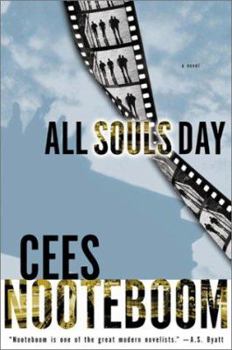All Souls Day
Select Format
Select Condition 
Book Overview
"An outstanding addition to an impressive oeuvre" Times Literary Supplement Arthur Daane, a documentary film-maker and inveterate globetrotter, wanders the streets of Berlin, a city whose recent past... This description may be from another edition of this product.
Format:Hardcover
Language:English
ISBN:0151005664
ISBN13:9780151005666
Release Date:November 2001
Publisher:Houghton Mifflin
Length:352 Pages
Weight:1.40 lbs.
Dimensions:1.2" x 6.3" x 9.3"
Customer Reviews
3 ratings
All Souls' Day
Published by Thriftbooks.com User , 17 years ago
Arthur Daane is a documentary maker, a camera operator, and a lonely man. His wife and child, who died years earlier, haunt his waking life. He has a solid group of friends, a rag-tag trio of intellectuals who do their best to keep up his spirits, but as with all people suffering from the demons associated with the death of loved ones, their best can never be enough. So, he travels about Europe, working for commission when he needs the money, spending time on his personal project when he does not. He walks, he thinks, he remembers. Soon, however, a new presence enters Arthur's life. She is Elik, a young Ph.D. student studying an obscure twelfth century Spanish queen. He is attracted to her mystery, she is attracted to his silence. A romance begins, one that is confusing to them both. And that, in a nutshell, is the entire novel. Nooteboom writes at a leisurely pace, allowing Arthur to ponder all manner of philosophical and cultural problems. A walk for Arthur is not merely a walk - it is nearly an essay, with statues inspiring history, trees inspiring philosophy, dogs inspiring memory. Generally, Arthur's thought connections are interesting and relevant however, they often seem more padding than anything else. The first hundred or so pages of the novel occupy themselves with Arthur's journey around Berlin, his current residence. While he walks, he remembers snippets of conversation with his friends Victor, Arno and Zenobia, these isolated items of character-building a prelude to a meeting at their favourite restaurant. Unfortunately, his three closest friends - the absent Erna notwithstanding - function more as mouthpieces for Nooteboom, rather than as characters in their own right. Conversations, when the occur, are punctuated with random facts that serve to link topics together, allowing the author to dazzle us with his varied and wide-ranging intellect. This is fine, except that Arthur's friends never progress beyond this fact-serving. They are stilted, because all they can be are repositories of knowledge. We are left to wonder why Arthur wants to be around them, and why they would want to be around him. A fine example comes from an early conversation between Arno and Victor: 'How on earth can you people call it cheese?' 'Luther, Hildegard von Bingen, Jakob Bohme, Novalis, and Heidegger have all eaten this cheese,' Arno said. 'The penetrating ordor that you smell is the German version of eternity. And the translucent substance that you see, with the dull sheen of candle wax, might very well represent the mystical heart of my beloved Vaterland.' All very fine, but their conversations never progress beyond this babble of knowledge swapping. Are we expected to believe that there are people who talk like this? And if they have been eating at the same restaurant for years, surely Arno would not lambast the table with this nugget of information upon arriving at the cheese dish? It all smacks of a writer writing the scene
How to see the world
Published by Thriftbooks.com User , 21 years ago
This novel develops in a much slower, traditional way than Nooteboom's other novels but this slowness is appropriate for the subject matter. The strength of this novel is the incredible way Nooteboom through words, allows us to see the world as Arthur sees it - he processes visual images not words or logical formulations. We are drawn into his experience of verbal overload, of stumbling to say in words what is known in visual or aural images. The second success of the novel is it's accurate portrayal of a specific intellectual time - Hegel, Camus, Volans, Pedereski, Hildegard ... it was so familar as to be eerie ... for the novel Berlin with Dutch, German, Russian individuals. And yet in some strange way the same as my college days in rural Wisconsin with students from Uganda, Honduras ... In some way Nooteboom has captured the intellectual life of an era and successfully made it universal.Throughout the novel - verbally and by plot - the volume addresses the issue of history - personal, recent, and ancient. The juxtaposition of Arthur's visual record of history, of his friend's intellectual understanding and of his "girl friend's" archival search for history is effective at forcing the reader to think. Often this is done by small details - a statue that fallen still has a cap in place where a real cap would have fallen off, the timeless sound of conches in Japanese monasteries, the sound of tires on wet pavement ...This is a novel that challenges the way you perceive the world rather than simply presenting the challenge that Arthur is facing. Arthur having lost wife and child in an airplane accident is forced to reevaluate his world. The novel says the rest of us should do so without a prod like Arthur's.
One of the world's best living writers
Published by Thriftbooks.com User , 22 years ago
I just finished reading this book and cannot recommend it enough. It is a sort of novel of ideas that encompasses traditional German philosophy as well as more modern issues. The story and characters are strong, and the portrayal of Berlin as an historical but ever-changing city is dead-on. This novel is longer than most of Nooteboom's others, but just as good a starting place if you're unfamiliar with his books.





